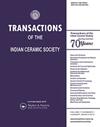IF 1.5
4区 材料科学
Q3 MATERIALS SCIENCE, CERAMICS
引用次数: 1
摘要
摘要:采用Al(NO3)3.9H2O和NaOH溶液对LA103Z镁锂合金微弧氧化陶瓷层进行Mg-Al LDH封堵处理。研究了处理温度对微弧氧化陶瓷层结构和耐蚀性的影响。讨论了镁铝LDH膜的形成机理和膜层的腐蚀机理。在较低温度范围内,温度的升高有利于LDH层的增加和增厚,膜层致密,耐腐蚀。在较高的温度范围内,温度的升高有利于LDH层尺寸的增大。层松散粗糙,耐蚀性降低。图形抽象本文章由计算机程序翻译,如有差异,请以英文原文为准。
Morphology and Corrosion Resistance of MAO/Mg-Al LDH Composite Film Obtained on LA103Z Mg-Li Alloy at Different Temperatures
ABSTRACT A solution of Al(NO3)3.9H2O and NaOH was used to perform Mg-Al LDH plugging treatment on the LA103Z magnesium-lithium alloy micro-arc oxidation ceramic layer. The effect of treatment temperature on the micro-arc oxidation ceramic layer structure and corrosion resistance was studied. The formation mechanism of Mg-Al LDH film and corrosion mechanism of the film layer were discussed. The results show that the sealing essence of Mg-Al LDH is that the Mg2+ obtained by dissolving the MgO component of the MAO film layer is combined with OH– in the hydrothermal solution to form a layered Mg(OH)2, the formation of LDH tends to be inside the pores. In the lower temperature range, the temperature increase is conducive to the increase and thickening of the LDH layer and the film layer is dense and corrosion resistant. In the higher temperature range, the increase in temperature is conducive to the increase in the size of the LDH layer. The layer is loose and coarse, and the corrosion resistance is reduced. The composite film is the densest at 90oC, and its insulation and corrosion resistance are better than the composite film obtained at other temperatures, the MAO film and the substrate. GRAPHICAL ABSTRACT
求助全文
通过发布文献求助,成功后即可免费获取论文全文。
去求助
来源期刊

Transactions of the Indian Ceramic Society
工程技术-材料科学:硅酸盐
CiteScore
2.40
自引率
8.30%
发文量
12
审稿时长
2.3 months
期刊介绍:
Transactions of the Indian Ceramic Society is a quarterly Journal devoted to current scientific research, technology and industry-related news on glass and ceramics. The Journal covers subjects such as the chemical, mechanical, optical, electronic and spectroscopic properties of glass and ceramics, and characterization of materials belonging to this family.
The Editor invites original research papers, topical reviews, opinions and achievements, as well as industry profiles for publication. The contributions should be accompanied by abstracts, keywords and other details, as outlined in the Instructions for Authors section. News, views and other comments on activities of specific industries and organizations, and also analyses of industrial scenarios are also welcome.
 求助内容:
求助内容: 应助结果提醒方式:
应助结果提醒方式:


